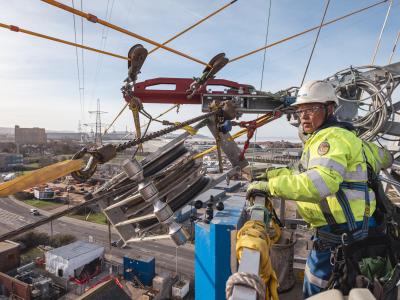
Completion of wiring works in Avonmouth
Works completed ahead of schedule
National Grid has completed work to hang the wires - or conductors - from lattice pylons in Avonmouth’s industrial area ahead of schedule, reducing impacts on key local roads.
Work to install the conductors - a process known as stringing - was started in January between the 27 newly built lattice towers that take the Hinkley Connection through Bristol Port land, over the River Avon, through Avonmouth and into Crooks Marsh to connect with Seabank substation.
To minimise disruption to local businesses in Avonmouth’s industrial area where the stringing was taking place, National Grid contractors Balfour Beatty adopted a new technique which uses a pulley system rather than installing scaffolding.
The pulley system is already used to replace or remove wires (known as conductors) but it is the first time the team has used it for the recent stringing work.
Our project team and contractors are constantly looking for ways to minimise disruption to local people and businesses across the route
Ropes and blocks were used to pull conductors between the pylons and away from properties and business. All people and equipment below the conductors were protected.
As well as being safer, the technique ended up being more effective and the stringing work took less time than expected.
Steve Haskayne, Hinkley Connection Project Director commented: “Our project team and contractors are constantly looking for ways to minimise disruption to local people and businesses across the route.
By adopting the pulley system, we were pleased that we only needed one short closure to St Andrew's Road, significantly reducing the disruption to businesses, people's livelihoods and the local community.
Stringing across all pylons along the route will have concluded by early 2024.







